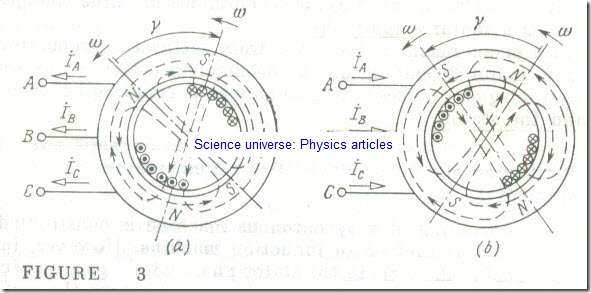Motoring and Generating Action of a Synchronous Machine
Like other electrical machines, synchronous machines may be operated either as generators or as motors. Which action of, the two does take place depends on the interaction between the magnetic fields set up by the currents in the stator and rotor windings.
Consider the operation of a two-pole machine. The superposition of the magnetic fields due to the currents in the phase windings of the stator excites in a synchronous machine (in much the same way as this happens in an induction machine) a magnetic field (see Sec. 14.3) which rotates at an angular velocity ɷ . An approximate distribution of the rotating magnetic field in the magnetic circuit of a synchronous machine running as (a) a generator and (b) a motor is shown by dashed lines in Fig. 3. As is seen, it may approximately be visualized as a pole pair on the stator, rotating at an angular velocity ɷ .
Similarly, the magnetic field set up by current in the winding of the revolving rotor may be approximately visualized as a rotating pole pair on the rotor.
If we neglect any losses in a synchronous machine, then, with no torque developed at the shaft, the axis of the rotor poles will be in line with that of the stator poles.
If we wish a synchronous machine to operate as a generator and supply electric energy to the line, we must increase the mechanical torque applied by its prime mover to the shaft. Then the increased driving torque will cause the axis of the magnetic poles on the rotor to move through an angle γ relative to the axis of the stator poles in the direction of rotation (Fig 3 a). This will also cause a change in the resultant magnetic field produced by the superposition of the stator and rotor magnetic fields and, in consequence, the current in the stator windings. The interaction of this current with the magnetic field of the rotor produces the braking torque acting on the rotor. This is nothing other than the conversion of the mechanical power supplied by the prime mover into the electric power by the generator connected to the electric system. The magnetic poles on the rotor appear to pull along with them the magnetic poles on the stator.
If now, instead of a driving torque, we apply to the shaft a mechanical load, the axis of the rotor poles will move through an angle with respect to the axis of the stator pole against the direction of rotation (Fig 3 b). As before, there will appear currents in the stator winding and there will appear electromagnetic forces due to the interaction between the stator currents and the rotor field, but now these forces will tend to pull the rotor along in the direction of rotation. This is nothing other than the conversion of the electric energy drawn from the supply line into mechanical power available at the output shaft. In this way, a synchronous machine changes to operation as a motor.
A synchronous machine goes over from acting as a generator to acting as a motor depending on the mechanical action on its shaft, with electromagnetic forces acting as an elastic coupling between the rotor and the stator.

